From the sun-kissed terraces of Venice to the vibrant squares of Rome, the scent of freshly baked Italian bread wafts through the air, a golden brown emblem of ‘la dolce vita.’
This aroma, mingling the earthy tones of the Italian countryside with the lively essence of quaint streets adorned with pastry shops, is not just about food; it’s a celebration of tradition and communal joy. In the heart of Michigan, particularly in the Grosse Pointe community, there exists a profound appreciation for these traditional artisanal breads and pastries, akin to the warmth felt in Italian families.
In this culinary guide, we delve into the rich world of homemade Italian bread recipes, showcasing the variety of Italian bread and pastries that bring people together. We’ll also share essential tips for crafting homemade bread—a staple revered in both Michigander and Italian households.
The journey to perfecting Italian bread begins with selecting high-quality ingredients like bread flour and extra virgin olive oil, ensuring your loaf has that signature chewy crust and golden brown allure.
For those looking to dive into homemade Italian bread making, the process often involves combining active dry yeast with warm water, gradually mixing in the bread flour, olive oil, and, maybe, a pinch of table salt. Once transformed into a soft bread dough, this mixture can be kneaded on a lightly floured surface or with a dough hook attachment in a stand mixer until smooth and elastic.
Bread recipes often call for allowing the dough to rise in an oiled bowl, covered with plastic wrap, until it doubles in size—a testament to the magic of the active dry yeast at work. After shaping the dough into a loaf of Italian bread, it’s placed on a parchment paper-lined baking sheet or a prepared baking pan, ready for the oven. Cooking spray or a light brushing of olive oil can prevent sticking, while an egg wash or sprinkling of flour might add texture and visual appeal to the crust.
Whether you’re aiming to bake garlic bread, rye bread, French bread, or the classic Italian loaf, the versatility of standard bread recipes allows for endless variations. Some may prefer adding herbs or incorporating whole wheat or other bread flour types for a different flavor profile. The key to exceptional homemade bread lies in the precise balance of ingredients, from the amount of water—never boiling, but relatively warm—to the ratio of instant yeast or active dry yeast used.
Storing homemade Italian bread properly is crucial to maintaining its freshness. Once completely cooled, bread loaves can be kept at room temperature in a plastic bag or wrapped in a tea towel. For longer storage, wrapping the bread in plastic wrap and placing it in the refrigerator overnight can keep it fresh and ready to be enjoyed the next day. If you want to store homemade Italian bread dough, it can be frozen for later use. Just make sure to defrost it in the fridge before baking.
Baking bread at home, especially following family recipes passed down through generations, is a delicious way to connect with one’s heritage and create lasting memories. From the initial mixing of the dough in a large mixing bowl to watching it rise under a tea towel, each step in bread making is filled with anticipation and joy. Whether you’re making two loaves to share with friends or enjoying the satisfaction of bread turned out perfectly from the baking pan, the experience of homemade bread is unparalleled.
Join us as we embark on a journey to Italy through the lens of bread and pastries. Let’s celebrate the warmth and artistry of Italian baking together.
Crafting Authentic Italian Bread: The Artisan’s Touch
Italian bread is more than just a staple. It’s a statement, a symbol that sustains generations of long-standing culinary traditions in Italy. Every region has its specialties. Making bread is an art form, a labor of love that requires patience, skill, and the right ingredients, like high-quality bread flour and extra virgin olive oil. In Italy, bakers take pride in their creations, often developing secret family recipes passed down through generations. Michigan’s vibrant Italian-American community has adopted cherished homemade Italian bread recipes from these relatives, introducing the aroma of freshly baked bread to the American Midwest. The art of baking Italian bread is a delicate balance between science and intuition. The texture, taste, and appearance are all carefully considered by passionate artisanal bakers. Each step, from the selection of ingredients to the precise timing in the oven on a prepared baking sheet, contributes to the golden brown end result.

Baba Rustico: Naples’ Savory Twist on a Classic
Venturing beyond the traditional sweet Baba, Baba Rustico offers a savory exploration of Neapolitan flavors. This unique take on the classic, typically drenched in rum or limoncello, is reimagined with savory elements such as cheese, salami, and sun-dried tomatoes, transforming it into a moist and flavorful delicacy. The light baba dough perfectly complements the depth of the savory fillings, creating a delightful balance.
Crafting Baba Rustico
The creation of Baba Rustico is a careful blend of tradition and innovation. While retaining the airy texture characteristic of its sweet counterpart, the dough is enriched with savory ingredients. Finely chopped salami, cheese cubes, and sun-dried tomato pieces are folded into the risen yeast dough, ensuring a rich taste in every bite. Baked in a ring-shaped mold until golden, the savory Baba Rustico emerges as a testament to the culinary creativity of Naples. Enjoyed as is or alongside an array of cured meats and cheeses, it is a versatile addition to any gathering.

Ciabatta: The Bread with a Slipper Bell
With its porous structure and chewy interior, Ciabatta earned its name from its likeness to an old-style slipper. However, it’s anything but old-fashioned in taste. Born in the 1980s out of a desire for innovation and changing dietary preferences, Ciabatta quickly became a global favorite. Perfecting Ciabatta in Your Bread Machine Although Ciabatta might seem challenging to perfect, you can achieve that soft, airy interior and slightly charred crust using the best bread machine. Keep the dough wet, handle it gently, and give your bread loaves a burst of steam for those desired results.
Perfecting Homemade Ciabatta
Making Ciabatta from scratch is a labor of love. The process involves creating a highly hydrated dough and using a preferment like poolish to add depth of flavor. With a combination of flour, water, yeast, and salt, it might seem simple in theory, but mastering the technique takes practice. The trick is to keep the dough wet and handle it gently with minimal kneading while allowing for a long fermentation period. Baked at high temperatures with a burst of steam, the result is a delectable bread with a crispy crust and airy interior that captures the essence of traditional Italian baking. Enjoy it as part of an antipasto platter, or use it to create delicious sandwiches. Let Ciabatta add its charm to your meals.

Ciriola: Rome’s Bread, Simple and Elegant
In the heart of Rome, Ciriola captures the culinary spirit of the city with its simplicity and elegance. This slender, baguette-esque loaf is celebrated for its unique texture — a crispy, golden brown crust housing a soft, chewy interior. Ciriola shines across a spectrum of dishes as a cornerstone of Roman cuisine, from the foundation of sumptuous sandwiches and antipasti to being savored in its simplest form, drizzled with extra virgin olive oil and a pinch of table salt.
The Craft of Ciriola: Rome’s Culinary Heritage
The creation of Ciriola is deeply rooted in Roman tradition, requiring nothing more than the basic yet precise components of high-quality wheat flour, yeast, salt, and warm water. Once mixed in a large bowl, the dough is handled with care, shaped into its iconic slender silhouette, and scored with a sharp knife along the top, guiding its expansion as it bakes to perfection. The result is a bread that’s crunchy on the exterior yet tender within, embodying the unpretentious yet profoundly satisfying taste of Roman baking. In Rome’s bustling streets, Ciriola stands as a testament to the enduring allure of Italian bread-making, showcasing the timeless appeal of Italian cuisine celebrated across the globe.
Coppia Ferrarese: Ferrara’s Unique Twist on Bread Tradition
Originating from Ferrara, Coppia Ferrarese stands out with its intricate twisted shape, a nod to the area’s rich baking heritage. It boasts a delightful contrast between its crunchy exterior and tender inside, crafted from premium ingredients, including wheat flour, lard, malt, and olive oil. The bread’s iconic twist is achieved through expert hand-rolling techniques, while the wood-fired oven baking process accentuates its distinctive taste. Ideal as an accompaniment to meats and cheeses or enjoyed simply by itself, Coppia Ferrarese encapsulates the essence of Ferrara’s culinary traditions in every bite.
Crafting Coppia Ferrarese: A Mastery of Tradition
The process of making Coppia Ferrarese is a testament to the artistry and expertise of Italian bakers. Starting with a blend of fine wheat flour, water, lard, malt, and a hint of olive oil, the dough gains its unique flavor and texture. The critical step of hand-rolling the dough into its signature twist demands precision. It imbues each loaf with beauty and flavor. Traditionally baked in a wood-fired oven, this method elevates the bread’s taste and fills the air with an irresistible aroma. Serving as a beautiful homage to Italian baking creativity, Coppia Ferrarese is perfect for enhancing any meal or enjoyed on its own, inviting one to explore Ferrara’s rich flavors and traditions with each bite.
Crescentina: The Quintessential Bread of the Emilia-Romagna Region
Crescentina, affectionately known as Tigelle in some circles, is a bread that encapsulates the heart and soul of Italy’s Emilia-Romagna region. This petite, round bread is distinguished by its enticing aroma and unique taste, passed down through generations, making it a staple of Italian culinary tradition. Crescentina serves not only as a delicious bread but also as a symbol of the rich and vibrant flavors that characterize the communal spirit of Italian dining experiences.
The Delightful Simplicity of Crescentina
At its core, Crescentina showcases the beauty of simplicity in Italian cuisine. The dough, a blend of flour, water, yeast, and just a hint of olive oil, is shaped into small, thick disks. Traditionally, these disks are cooked between two heated clay discs, a method that gives Crescentina its crisp exterior while maintaining a soft, chewy interior. Today, griddles or pans might be used, but the essence of this cooking technique remains the same. Typically served warm, Crescentina is incredibly versatile, making it the perfect accompaniment to various Italian charcuterie, cheeses, and spreads. Its role in fostering shared meals and lively conversations among friends and family embodies the true spirit of Italian conviviality. Crescentina is more than just bread; it is a celebration of culture, tradition, and the simple joys of sharing good food.
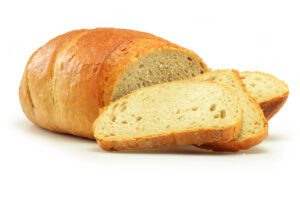
Filone: A Taste of Tuscany’s Hearth
Filone stands as a beloved staple within the Tuscan bread family, embodying the essence of Italian rustic baking. This bread differentiates itself from the traditional saltless Tuscan varieties by welcoming salt into its dough, greatly enhancing its overall flavor profile and making it the perfect complement to Tuscany’s hearty and rich culinary offerings. Characterized by its elongated shape, Filone features a delightfully crisp crust enveloping a soft and airy core, eagerly waiting to soak up the vibrant sauces and gravies that grace Tuscan dining tables.
Baking Filone: The Heart of Tuscan Tradition
The journey to crafting Filone at home begins with a blend of premium bread flour, warm water, active dry yeast, and a touch of salt. Through diligent kneading, either by hand on a lightly floured surface or with a stand mixer fitted with a dough hook attachment, the dough is brought to life, imbued with air pockets that define its texture. Following a period of rest, the bread dough is allowed to rise and double in size in an oiled bowl covered with plastic wrap, and it’s shaped and set for final proofing. Baked on a prepared baking sheet until it reaches a golden brown perfection, Filone emerges as not just bread but a symbol of Tuscan tradition, ready to be sliced and enjoyed with everything from robust stews and soups to delicate cheeses and savory cured meats, making every meal absolutely delicious.
Focaccia: A Timeless Italian Delight
Focaccia is a hallmark of the simplicity and depth found within Italian cuisine. Its roots go back to ancient Rome, where it was known as “panis focacius.” This flatbread was traditionally cooked on hot ashes. Today, its characteristically moist and airy texture, enriched with liberal amounts of olive oil, distinguishes it in flavor and feel.
Crafting Focaccia in Your Own Kitchen
Embarking on the journey of homemade focaccia is an exploration of taste and texture. Start with premium flour, active yeast, and the best extra-virgin olive oil available. The key lies in patience and affection, allowing the dough to rise adequately to capture air and achieve that signature light interior. Prior to baking, indentations are made in the dough, which are then generously anointed with more olive oil and sprinkled with your choice of aromatic herbs like rosemary or thyme, yielding a crust that’s delightfully crispy on the outside yet tender and fragrant inside.
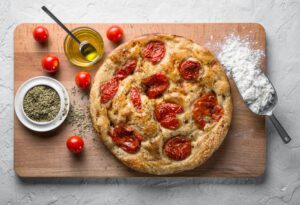
Focaccia Barese: A Culinary Gem from Apulia
Focaccia Barese stands out in Italy’s extensive bread tradition as a treasure from the sun-kissed region of Apulia. Known for its aromatic flavor, soft texture, and the eye-catching presence of tomatoes and olives on its surface, Focaccia Barese offers a unique eating experience. This bread distinguishes itself from other Italian focaccias through a meticulous hydration process, resulting in a distinctive moistness and lightness.
The Artisanal Creation of Focaccia Barese
The excellence of Focaccia Barese lies in its artisanal preparation process. The dough is crafted from a careful selection of high-quality flour, water, yeast, and salt, with the addition of local olive oil to enrich the flavor and ensure a tender crumb. Before baking, the dough is lovingly topped with cherry tomatoes, black olives, and occasionally oregano, creating a harmonious blend of flavors as it cooks. The outcome is a golden, aromatic focaccia that is a testament to Apulia’s rich culinary heritage. Focaccia Barese is not merely a bread but a celebration of the region’s generous produce and long-standing traditions. It is cherished by both locals and visitors, serving as a reminder of the enduring charm and skill of Italian baking.

Friselle: A Staple of Apulian Tradition
Friselle occupies a special place in Apulia’s gastronomic landscape, celebrated for its unique preparation and lasting appeal. Originating from peasant cuisine, this twice-baked bread embodies simplicity and sustainability, made from basic components like wheat flour, water, yeast, and salt. Initially baked as a loaf, it’s then halved and baked again to achieve a crisp, dry texture.
Homemade Friselle: A Labor of Love
Making Friselle is a revered family tradition in many Italian homes, allowing for personal touches in the recipe. Its versatility shines when topped with fresh tomatoes, herbs, and olive oil or as a crunchy accompaniment to soups and stews. The process starts with mixing wheat flour, water, yeast, and salt into a smooth dough, which is then shaped into mini bagels and baked. After cooling, they’re sliced and returned to the oven for a second bake. This results in a crunchy bread enjoyed across generations.

Pane Altopascio: A Taste of Tuscan Legacy
Hailing from the town of Altopascio in Tuscany, Pane Altopascio is celebrated for its golden crust and tender inside, embodying the essence of Tuscan baking traditions. Originating in the medieval era, it was an essential sustenance for pilgrims traveling the Via Francigena.
The Art of Pane Altopascio
This bread’s exceptional flavor and texture derive from select wheat flour, careful fermentation, and baking in a traditional wood-fired oven. Contrary to the saltless Pane Toscano, Pane Altopascio includes a touch of salt, enhancing its taste and making it a versatile addition to a wide range of Italian dishes. Each loaf is a tribute to the skilled artistry of Tuscan bakers.

Pane di Casa: The Homemade Italian Bread of Comfort
If any bread recipe encapsulates the essence of Italian comfort, it’s the Pane di Casa (Homemade Italian bread). This unsalted, crusty bread, finished with a chewy crust, speaks volumes. It’s excellent for soaking up a hearty sauce, creating the perfect sandwich, or forming the center of a bread-loving feast.
Creating Pane di Casa in Your Kitchen
With a few simple ingredients and a touch of love, you can recreate that comforting aroma of fresh bread in your home. The key is a slow fermentation process and careful handling to protect the dough’s delicate air pockets, resulting in an authentic, rustic Italian loaf. It’s the perfect way to bring warmth and tradition to any meal with friends and family.
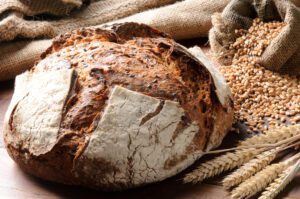
Pane di Segale: Northern Italy’s Hearty Loaf
Pane di Segale, or Italian Rye Bread, embodies the robust culinary spirit of Northern Italy. Esteemed for its full-bodied flavor and dense, slightly sour consistency, this bread is ideally suited to the region’s cooler climate, thanks to rye’s hardiness over wheat. It complements a wide variety of accompaniments, from butter to fine cheeses, showcasing the rich diversity of Italian bread traditions.
Homemade Pane di Segale
Preparing Pane di Segale in your kitchen involves a blend of rye and wheat flour and leveraging a sourdough starter for its characteristic tangy flavor and moist texture. A prolonged fermentation period and steamy oven environment are vital for cultivating its unique crust and taste, offering a distinctive touch to any dining experience.

Pane Pugliese: The Rustic Gem of Southern Italy
Pane Pugliese is the pride of Southern Italy, distinguished by its thick crust and fluffy interior. Crafted from superior durum wheat, it mirrors Puglia’s agricultural bounty. It possesses a moist crumb, which is attributed to its highly hydrated dough.
Exploring Homemade Pane Pugliese
The adventure of baking pane Pugliese at home involves mastering a high-hydration dough and utilizing a pre-ferment like a Biga to deepen the flavor. This culminates in a bread that boasts a mildly sweet and nutty profile. Baked at elevated temperatures, it forms a dark, gratifying crust. Ideally paired with the hearty fare of Southern Italy, pane Pugliese captures the soul of Puglia’s gastronomic legacy.
Piadina Romagnola: Romagna’s Beloved Flatbread
Piadina Romagnola is a testament to the simplicity and richness of Italian cuisine, originating from the heart of Romagna. This esteemed flatbread has straightforward yet flavorful ingredients: flour, water, salt, and lard or olive oil. Characterized by its thin, soft, yet slightly crispy texture, Piadina is a versatile base for a myriad of fillings such as prosciutto, cheese, and vegetables. Cooked traditionally on terracotta or a flat griddle, it acquires a distinct char and taste that epitomizes Romagnolan culinary culture. More than just food, Piadina symbolizes the warmth and traditions of Romagna, offering a slice of Italy’s culinary heritage with every bite.
Embracing Homemade Piadina Romagnola: A Culinary Adventure
The journey of making Piadina at home is a rewarding culinary adventure, starting with mixing flour, salt, lard or olive oil, and water to form a pliable dough. After allowing the dough to rest, it’s portioned, rolled out thinly, and cooked until beautifully charred. The beauty of Piadina lies in its versatility, encouraging creativity with various toppings for any occasion. Whether savored in the comfort of home or the streets of Romagna, Piadina is a cornerstone of Italian food culture,
Torta al Testo: The Heart of Umbrian Bread Making
Torta al Testo, known locally as “pane sotto il fuoco,” is an ancient Umbrian flatbread traditionally cooked on a stone or cast iron plate, referred to as ‘testo.’ This bread, simple in ingredients yet rich in flavor, is a staple of Umbria’s rustic cuisine. It is often served with or filled with regional specialties like cured meats, cheeses, or greens.
The Essence of Torta al Testo
The preparation of Torta al Testo involves a basic dough consisting of flour, water, baking soda, salt, and a touch of olive oil mixed to create a soft dough. Its allure lies in the traditional cooking method; shaped into a disc, the dough is placed on a preheated ‘testo,’ puffing up and crisping on the outside while staying soft and chewy inside. Flipping ensures an evenly cooked, golden crust, emblematic of this Umbrian favorite. When sliced and filled, Torta al Testo becomes a comforting embodiment of Umbrian culinary heritage, cherished in both festive and daily meals.

Exploring Italian Pastries: Sweet Temptations
Italy, a country celebrated for its unparalleled contributions to the culinary world with staples like pasta and pizza, also offers an equally impressive but less globally recognized treasure trove of pastries. Each region brings its own story and unique flavors to these sweet temptations, creating a rich tapestry of taste that extends far beyond the more ubiquitous elements of Italian cuisine.

Baba al Rum: The Neapolitan Rum-Soaked Delight
Baba al Rum, a sumptuous dessert hailing from Naples, has transcended its regional origins to become a beloved treat worldwide. This small, yeast-leavened cake, known for its luxurious, spongy texture, is generously soaked in rum syrup, imbuing it with a distinctive moistness and rich flavor profile. The origins of Baba al Rum trace back to the adaptation of the Polish Kugelhopf, which underwent a transformation at the hands of French and then Italian bakers. This culminated in the creation of this Neapolitan delicacy.
The Decadence of Baba al Rum
The preparation of Baba al Rum epitomizes the finesse of pastry craftsmanship, demanding patience and precision to perfect its texture and taste. The dough, a harmonious mix of flour, eggs, sugar, and milk, is expertly mixed and allowed to rise, resulting in its characteristic airy yet indulgent consistency. After baking, the cakes are thoroughly soaked in a syrup composed of sugar, water, and ample rum, ensuring each bite is lusciously moist and flavorful. Often garnished with whipped cream or fruit, Baba al Rum is not only a delight for the taste buds but also a visual treat, embodying the bold and decadent essence of Neapolitan desserts. Through Baba al Rum, we are invited to experience the pinnacle of Italian indulgence, a reminder of the rich cultural heritage that informs Italy’s unparalleled culinary landscape.

Bomboloni: Italy’s Beloved Doughnut
Bomboloni are Italy’s captivating rendition of the beloved doughnut, embodying the joy of sweet, fried pastries. These airy, yeast-leavened delights are fried to achieve a crispy exterior that encases a tender, fluffy heart. Distinctive for their luscious fillings—be it velvety custard, rich chocolate, or tangy fruit jam—bomboloni offers a delightful surprise with every bite, making them irresistibly appealing.
Diving into the Delight of Bomboloni
The secret to perfect bomboloni lies in the equilibrium of its dough and the decadence of its filling. Prepared from a dough that includes flour, eggs, sugar, butter, and yeast, bomboloni puffs into round golden morsels upon frying. While still warm, they’re rolled in sugar, adding a layer of sweetness and texture before filling with a chosen delicacy. Best enjoyed fresh, bomboloni exemplify Italy’s appreciation for life’s simple yet profound pleasures, showcasing how classic ingredients, combined with time-honored techniques, can create extraordinary experiences.

Brioche col Tuppo: Sicily’s Sweet Delight
Brioche col Tuppo emerges as a confectionery jewel from the vibrant heart of Sicily, encapsulating the island’s penchant for indulgent, sweet breads. This unique pastry gets its name from its distinctive shape, mirroring a traditional bun hairstyle (“tuppo”) frequently adorned by Sicilian women. Renowned for its versatility, Brioche col Tuppo is equally delightful whether paired with a scoop of smooth gelato for a refreshing treat or savored alongside a steaming cup of espresso as a morning or afternoon delight.
The Sweet Craftsmanship of Brioche col Tuppo
Crafting Brioche col Tuppo is an exercise in the art of patience and precision. Its enriched dough, a harmonious blend of high-quality flour, eggs, sugar, and copious amounts of butter, achieves a delicate balance between lightness and richness. Following a meticulous fermentation process that allows the flavors to mature, the dough is shaped by hand, paying homage to its namesake, “tuppo.” It’s baked after an egg wash glaze until it reaches a luscious golden brown. The outcome is a pastry that’s not overly sweet, offering a cloud-like interior and a glossy, inviting exterior. Brioche col Tuppo stands as a proud representation of Sicilian culinary ingenuity, blending tradition with impeccable taste to transcend the commonplace.

Cannoli: Sicily’s Pride
Among the most iconic of Italian pastries is the Cannoli, hailing from the sun-drenched island of Sicily. Characterized by its crisp, wafer-thin shell filled with a lusciously sweet ricotta mixture, the cannoli is as much a feast for the eyes as it is for the palate. This pastry not only represents a beloved dessert option but also carries with it a heavy dose of cultural heritage and history, standing as a symbol of Sicilian pride and craftsmanship.
Making Cannoli at Home
The art of making cannoli at home is a deeply rewarding endeavor that invites a touch of Sicilian charm into your kitchen. The process involves baking the delicate shells to achieve that signature golden hue and crisp texture, then carefully filling them with the finest ricotta mixture you can prepare, flavored with hints of orange zest and dotted with chocolate chips. The result is nothing short of a culinary masterpiece, embodying the essence of Sicilian dessert traditions.
Certosino: Bologna’s Festive Delicacy
Certosino, or Pan speziale, embodies the festive essence and culinary opulence of Bologna with its rich, spice-infused composition. This traditional Italian Christmas cake is dense with a lavish mix of almonds, pine nuts, candied fruit, and chocolate, offering a sumptuous celebration of the holiday season’s generosity.
Crafting the Quintessential Certosino
The art of making Certosino lies in the harmonious blend of its ingredients. A mixture of flour, honey, sugar, eggs, and a medley of spices, including cinnamon, nutmeg, cloves, and pepper, creates a base with a unique sweet and spicy profile. Enriched with dried fruits such as figs, raisins, and candied citrus peel, the cake’s texture and flavor complexity are elevated. Baked to perfection in a special mold, Certosino emerges with a golden crust, ready to enchant as a holiday dessert or cherished gift, celebrating the joy and tradition of the season.

Chiacchiere: Italy’s Carnival Classic
In the heart of Italy’s festive season, Chiacchiere stands out as a quintessential sweet treat, embodying the spirit and exuberance of Carnival. This beloved pastry, known by a myriad of names such as “frappe,” “bugie,” or “cenci” across different regions, carries with it whimsical connotations of light-hearted chats and playful tales, mirroring the airy and delicate nature of the confection itself. The tradition of enjoying Chiacchiere during Carnival is steeped in the culture of storytelling and merriment, making these pastries a symbol of communal joy and celebration.
The Art of Making Chiacchiere
The allure of Chiacchiere lies in their simple yet meticulous preparation, a process that brings joy to both those who make and those who indulge in them. Crafted from a dough that blends flour, eggs, sugar, a touch of butter, and occasionally a dash of wine or liqueur, these pastries are rolled out thin and cut into various shapes or tied in loose knots. Quickly fried to achieve a perfect golden crispness and finished with a generous dusting of powdered sugar, Chiacchiere captures the essence of Carnival – light, festive, and irresistibly tasty.

Maritozzo: Rome’s Sweetheart of a Bun
Deep in the historic lanes of Rome, Maritozzo is a cherished pastry that captures the essence of Italian sweet bread making. Soft and mildly sweet, this delightful bun becomes a luxurious treat once its center is lavishly filled with whipped cream. Maritozzo’s origins trace back to medieval Rome, where it symbolized love, often enhanced with honey and nuts. Presently, it remains a sought-after choice for breakfast or a snack, perfectly marrying the softness of the bread with the creamy sweetness of whipped cream.
Reveling in the Sweetness of Maritozzo
The creation of Maritozzo is a testament to the enduring legacy of Roman pastry art. The dough, a careful amalgamation of flour, eggs, sugar, and butter, rises to form the base of this aromatic bun. Once baked to golden perfection, the art lies in the filling – a cloud of freshly whipped cream, subtly sweetened, piped into the heart of each bun, elevating the humble bread into a sumptuous delight. Enjoying a Maritozzo offers a moment of indulgence and a connection to the rich tapestry of Rome’s pastry history.

Panettone: A Milanese Christmas Tradition
Panettone is a quintessential emblem of Italy’s festive culinary repertoire, with its origins deeply rooted in the city of Milan. This towering, dome-shaped bread captures the essence of Christmas through its light and airy texture, enriched with the vibrant flavors of candied fruits, raisins, and zesty orange peel. Celebrated for its elaborate preparation and rich taste, panettone is not just a holiday treat but a masterpiece of Milanese baking tradition, embodying centuries of artisanal skills and cultural heritage.
The Labor of Love Behind Panettone
The creation of this iconic bread reflects a true labor of love, demanding unparalleled dedication and expertise from Italian bakers. The intricate process begins with a carefully crafted dough, incorporating high-quality flour, eggs, sugar, butter, and yeast. An extensive fermentation process follows, involving multiple proofing stages that contribute to the bread’s signature voluminous stature and fluffy consistency. Masterfully blending candied fruits and raisins into the dough without compromising its delicate structure is a testament to the baker’s skill. Traditionally enjoyed after Christmas Eve dinner or on Christmas day, often with sweet hot beverages or sparkling wine, panettone transcends its role as a mere dessert, becoming a cherished holiday ritual that brings families together, celebrating the joy and warmth of the season.

Pasticciotto: The Heart of Puglia’s Pasticceria
Originating from the sun-drenched landscapes of Puglia, particularly revered in the Salento region, Pasticciotto embodies the soulful simplicity of Italian dessert culture. This beloved pastry, with its crisp shortcrust exterior yielding to a heart of creamy, lemon-infused custard, represents a harmonious blend of texture and flavor characteristic of Puglia’s rich culinary heritage. Baked to achieve a delicate equilibrium between its crunchy shell and soft, fragrant filling, Pasticciotto is more than just a pastry; it is a celebration of regional ingredients and traditional baking techniques, offering a delectable glimpse into the heart of Puglia’s Pasticceria.
The Sweet Simplicity of Pasticciotto
Pasticciotto, a beloved pastry hailing from the picturesque region of Puglia, Italy, is a perfect example of the artistry inherent in Italian baking. Revered for its simplicity and elegance, this delightful pastry features a tender, buttery crust made from a blend of flour, sugar, and butter, embracing a creamy heart of custard. The filling, a lush concoction of eggs, sugar, and milk, is subtly enhanced with lemon zest, lending a nuanced depth to its flavor profile. Each pasticciotto is a labor of love, embodying the dedication and passion of those who craft it, making it not merely a dessert but a homage to local heritage and culinary tradition. Often dusted with powdered sugar and served warm, it provides a comforting, indulgent experience deeply intertwined with the essence of Puglia’s pastry tradition. Pasticciotto is more than a treat; it’s a celebration of the rich, diverse tapestry of Italian regional desserts, delighting all who have the pleasure of tasting it.

Zeppole di San Giuseppe: A Saint’s Day Delicacy
Marking the celebration of Saint Joseph’s Day on March 19th, Zeppole di San Giuseppe is a heartfelt homage to fathers and revered saints alike. These exquisite pastries, whether deep-fried to golden perfection or baked to a light crisp, are filled with a sumptuous custard and crowned with a cherry, encapsulating the affection and reverence of the occasion.
The Heartwarming Tradition of Zeppole di San Giuseppe
The making of Seppole di San Giuseppe is steeped in tradition, embodying the warmth and generosity of Italian hospitality. The choux pastry, known for its feather-light texture, is an ideal base for the luscious custard filling. It is often enhanced with a hint of citrus to add a refreshing zest. Whether opting for the indulgence of the deep-fried version or the baked alternative’s subtler charm, these pastries celebrate flavor and texture. Topped with powdered sugar, they pay tribute to Saint Joseph and fathers and herald the arrival of spring with their bright and uplifting taste, securing their place as a treasured delicacy across Italy.
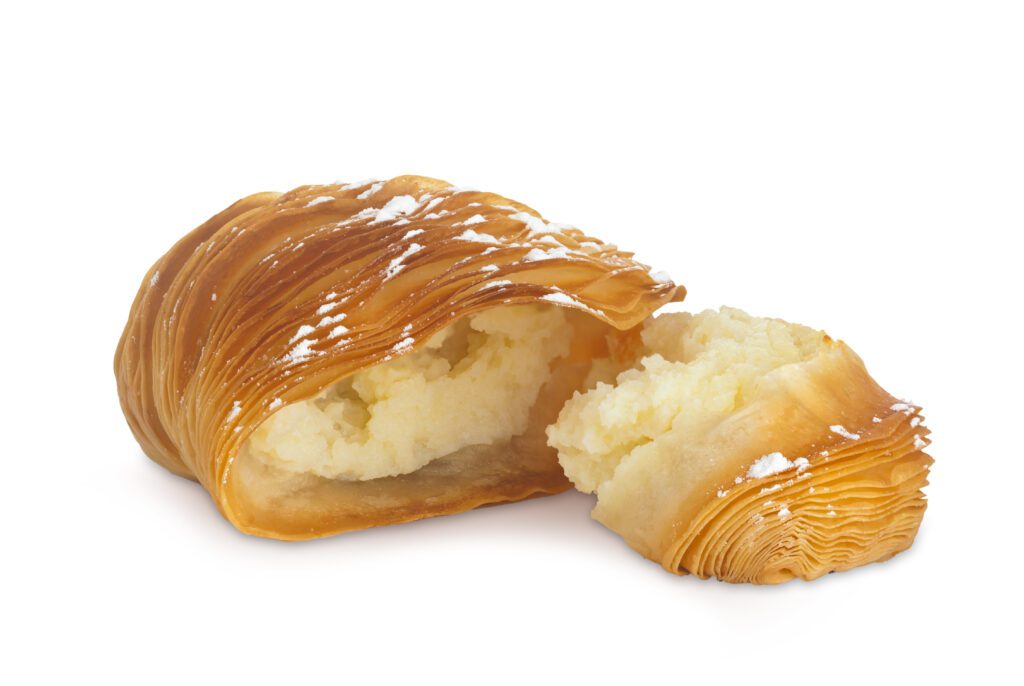
Sfogliatelle: The Conundrum of the Shell-Shaped Secret
Venturing northward to Campania, we encounter the Sfogliatelle. This pastry captivates with its intricate, shell-like appearance and flaky layers. The filling, typically a rich blend of sweetened ricotta, nestles within countless razor-thin layers of dough, creating a textural experience that is both complex and immensely satisfying. The Sfogliatelle is not just a pastry but a testament to the skill and patience of those who craft it.
Creating Sfogliatelle: Conquering the Conundrum
The journey to perfecting Sfogliatelle at home is akin to mastering an art form. The key lies in the meticulous preparation of the dough, which must be stretched and rolled to near-translucent thinness before being shaped into the pastry’s distinctive seashell form. This process demands both patience and precision, but the reward—a table adorned with these ornate, delicious creations—is well worth the effort. Through Sfogliatelle, we gain not only a delectable treat but also a deeper appreciation for the rich culinary heritage of Italy’s Campania region.
Sporcamuss: Apulia’s Irresistible Flaky Treat
Sporcamuss, aptly named for the playful mess it creates (“dirty mouth” in the local dialect), is another gem from Apulia’s esteemed culinary tradition. This delectable pastry embodies the simplicity and joy found in Italian dessert craftsmanship. Comprising squares of flaky puff pastry, filled with a sumptuous ricotta cream and finished with a dusting of powdered sugar, Sporcamuss offers a delightful interplay of textures that tantalize the palate.
Indulging in the Joy of Sporcamuss
The creation of Sporcamuss is a testament to the Italian ability to elevate basic ingredients into something truly extraordinary. The secret to its enchanting appeal lies in the quality of the ricotta filling—smooth, creamy, and lightly sweetened to perfection, creating a harmonious balance with the crisp, buttery layers of the puff pastry. Typically served warm, this pastry is a favored choice for an afternoon indulgence or as a sweet finale to a meal. Its straightforwardness, coupled with the sheer pleasure of enjoying something so delightfully messy, perfectly captures the spirit of Apulian cuisine. Sporcamuss is more than just a pastry; it’s an expression of the spontaneous and heartfelt warmth that characterizes dining in Apulia, securing its place as a treasured highlight within Italy’s extensive repertoire of regional desserts.

Struffoli: Naples’ Festive Sweet Treat
Struffoli, a cherished dessert from Naples, encapsulates the vibrant spirit of Italian celebrations, particularly around Christmas and Easter. This delightful dish consists of petite dough balls, each a bite-sized burst of sweetness, deep-fried to a golden hue and lavishly coated in honey. The contrast of the crispy exterior with the soft interior, all unified by the sticky sweetness of honey, creates a texture and flavor experience that is uniquely Struffoli.
The Joyous Creation of Struffoli
The creation of Struffoli is an act of communal joy, bringing people together through the shared pleasure of crafting and savoring this festive dessert. Made from a dough infused with citrus zest, lending a subtle aromatic note to the sweet base, these tiny treasures are adorned with colorful sprinkles, candied fruits, and nuts after being bathed in warm honey. Traditionally presented in a wreath or mound, Struffoli symbolizes abundance and festivity, making it a centerpiece of Italian holiday gatherings and a testament to the joyous spirit of Italian culinary traditions.
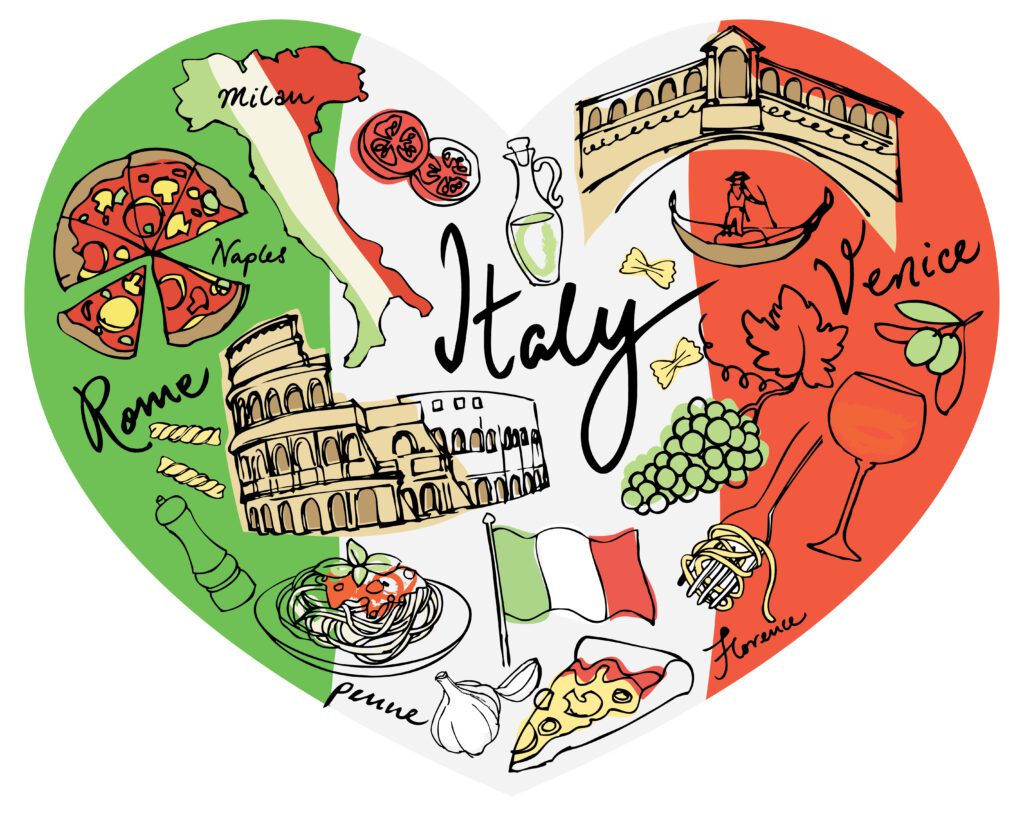
Michigan: The Heart of Italian Baking Renaissance
In the heart of the Midwest, Michigan stands as a vibrant testament to the enduring legacy of Italian-American culture and culinary traditions. Known for its rich tapestry of communities, the state has become a beacon for those seeking the authentic flavors and warmth of Italian baking. From the bustling streets of Grosse Pointe to the serene landscapes beyond, Michigan offers a slice of Italy’s gastronomic heritage, inviting all to partake in its bounty.
A Story of Two Cultures in Grosse Pointe
The story of Italian baking in Michigan is one of adaptation, innovation, and love. In places like Grosse Pointe, bakeries serve as cultural hubs, where the recipes of old-world Italy blend seamlessly with the spirit of the American Midwest. These establishments are not just businesses but vital parts of the community, bringing together families and friends over the shared love of good food. The Italian bakeries of Michigan are custodians of tradition, ensuring that the flavors of Italy continue to enrich the American culinary landscape.
Balancing Tradition and Innovation
Michigan’s Italian bakeries embody the delicate dance between preserving traditional methods and embracing new ideas. Generations of immigrant families have poured their hearts into crafting bread and pastries that echo the tastes of their homeland while also reflecting their new surroundings. This fusion of old and new has given rise to a unique culinary identity that respects its roots while exploring novel expressions of flavor and technique. As a result, Michigan has become a fertile ground for culinary innovation, where the essence of Italian baking evolves with each passing day.

The Bonding Power of Bread
Breaking bread, a universal sign of unity and fellowship, becomes a celebration when it is an Italian loaf or a handmade pastry. Michiganders, in particular, find the savor of Italian baking part of life’s rhythm.
Diving into the world of Italian pastries and breads is to be part of a rich culinary tradition that goes back centuries. Whether you’re enjoying a fresh baguette from your local bakery or making your own version at home, the warmth and flavor of Italy’s most loved baked goods invite you to relax, enjoy, and share the joy of life’s simplest pleasures.
Raise a Toast to Freshly Baked Italian Bread
At Ferlito’s, we celebrate the deliciousness of Italian baked goods and their power to bring people together. From Pasticciotto to Sporcamuss, Michigan’s love for Italian bread is a testament to the state’s diverse and welcoming spirit, showcasing how food has the ability to connect us all. So come and savor the flavors of Italy right here in Michigan and discover the joy that comes with every bite.
